Overview
Digital transformation in banking is not just beneficial; it is essential for enhancing operational efficiency and customer engagement. By integrating technologies such as AI, cloud computing, and big data analytics, banks can meet evolving customer expectations and navigate regulatory changes effectively.
How can banks ensure they are not left behind in this rapidly changing landscape? This article emphasizes the necessity of adopting a strategic approach to successfully navigate this transformation.
Leveraging tools like Avato’s hybrid integration platform can help banks overcome challenges and achieve their objectives. As a result, the integration of these technologies is a crucial step toward future success.
Introduction
In the rapidly evolving landscape of banking, digital transformation has emerged as a pivotal force reshaping how financial institutions operate and serve their customers. This comprehensive integration of advanced technologies is not merely a trend; it represents a fundamental shift from traditional banking practices to a more agile, customer-centric approach. As banks strive to enhance operational efficiency and meet the growing expectations of tech-savvy consumers, understanding the key drivers, technologies, and challenges of this transformation becomes crucial.
By embracing innovations such as artificial intelligence, cloud computing, and big data analytics, banks can unlock new opportunities for improved customer engagement and operational effectiveness. However, the journey is fraught with obstacles, including legacy systems, regulatory compliance, and the need for cultural change. What strategies can banks implement to overcome these challenges? This article delves into the multi-faceted world of digital transformation in banking, offering insights into strategic steps for success and the essential role of leadership in navigating this complex landscape.
Understanding Digital Transformation in Banking
The digital transformation of the banking industry signifies a comprehensive integration of digital technologies across all operational facets, fundamentally reshaping how these institutions function and deliver value to their clients. This evolution marks a departure from traditional banking practices, embracing flexible, technology-driven methodologies that significantly enhance user experiences and operational efficiency.
Key components of this transformation include:
- Cloud Computing: This technology facilitates scalable solutions, enabling banks to manage resources more effectively and respond swiftly to market fluctuations.
- Big Data Analytics: Financial institutions leverage extensive data to inform decision-making, assess risks, and offer tailored services.
- AI-driven Solutions: These play a crucial role in streamlining processes and enhancing client interactions through automation and predictive analytics, essential for boosting operational efficiency and client engagement.
As of 2025, over 60 countries have adopted or are in the process of implementing open banking regulations, reflecting a global shift toward more transparent and customer-centric banking practices. This regulatory landscape is driven by the need for financial institutions to securely exchange client information with third-party providers via APIs, fostering innovation while addressing data privacy concerns. The EU’s revised Payment Services Directive underscores the importance of compliance in the digital transformation of the banking industry.
Statistics reveal that 80% of consumers now prefer customized financial services, underscoring the imperative for banks to adapt to evolving client expectations. As highlighted by Yahoo Finance, “Digital banking has transformed customer expectations, with 80% of consumers expressing a preference for personalized banking experiences.” The rise of online banking has compelled the digital transformation of the banking industry to prioritize personalized experiences, utilizing generative AI tools to enhance service delivery and operational efficiency.
Successful examples of digital transformation within the banking sector showcase the potential benefits. Banks that have adeptly integrated emerging technologies such as AI and blockchain are leading the charge in digital transformation, enhancing client experiences and promoting financial inclusion. However, these advancements are not without challenges, including regulatory complexities and cybersecurity threats.
The online banking industry is actively addressing these challenges while seizing opportunities for improved user experiences and financial inclusion. The most successful players in the market will be those who can seamlessly integrate these technologies while maintaining client trust and compliance.
In summary, the implications of digital transformation for banks are profound. It necessitates a strategic shift in operational approaches, concentrating on enhancing customer engagement and operational efficiency. As the banking landscape continues to evolve, digital transformation will be essential for sustaining a competitive edge and meeting the demands of a rapidly changing market.
To support your organization during this transition, consider Avato’s five-step manual for technological advancement, which outlines critical strategies for effectively integrating legacy systems and utilizing new technologies. Additionally, explore case studies that highlight successful technological transformations in the banking sector, providing practical insights into best practices. Avato’s Hybrid Integration Platform can play a pivotal role in this journey, offering the necessary tools and strategies for successful technological change and system integration.
Connect with Avato today to discover how we can help you thrive in the AI landscape!
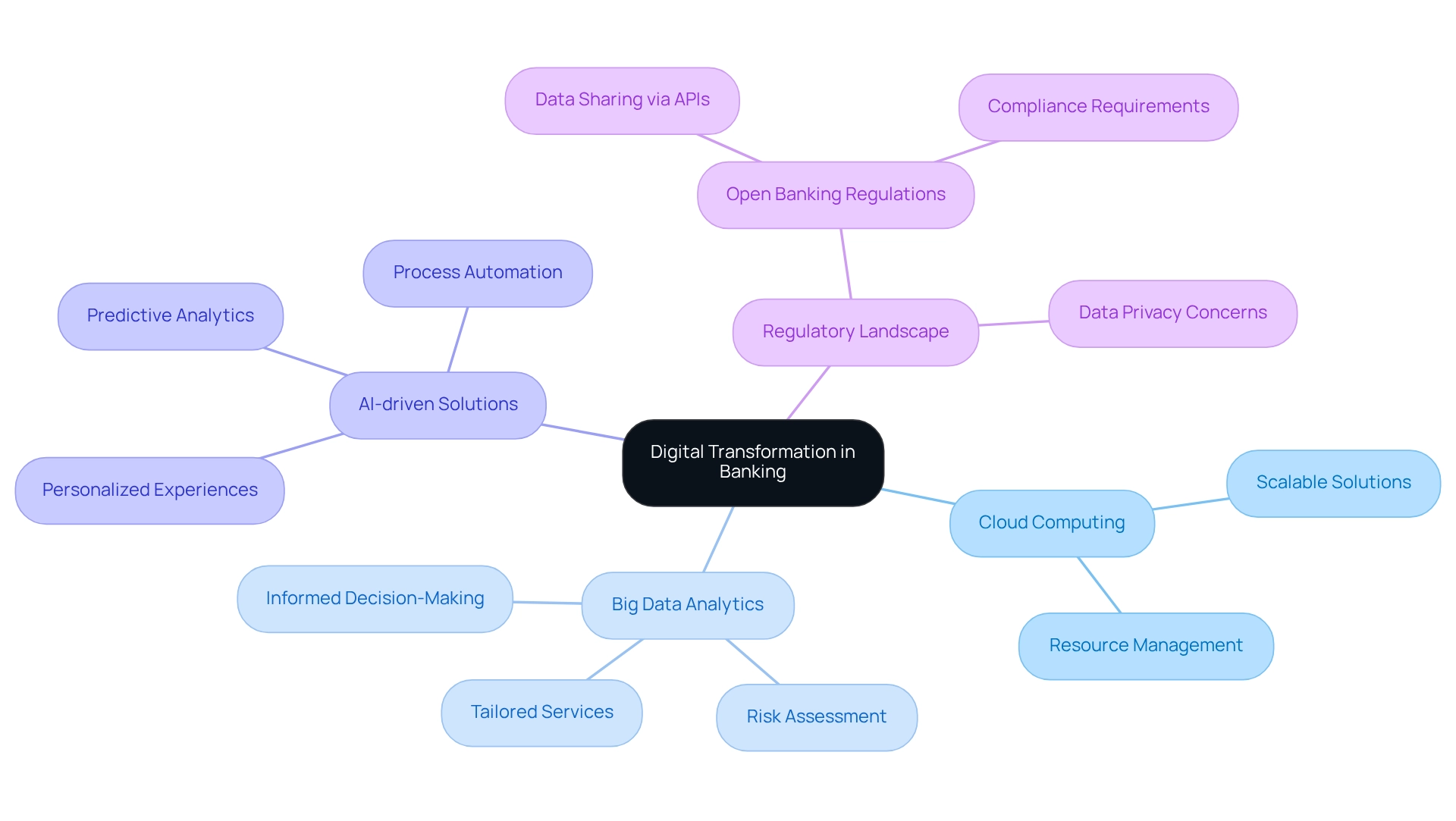
Key Drivers of Digital Transformation in the Banking Sector
Several factors are driving digital transformation in the banking industry, notably evolving customer expectations. In fact, 75% of U.S. consumers in 2025 express greater loyalty to brands that understand them on a personal level. This statistic underscores the necessity for financial institutions to provide seamless, personalized experiences across all channels. Moreover, more than half of consumers (55%) remain loyal because they genuinely appreciate the products available, highlighting the importance of aligning services with client preferences to nurture loyalty.
Avato’s hybrid integration platform plays a crucial role in enabling financial institutions to create these personalized experiences by seamlessly connecting disparate systems and data.
Competitive Pressures: The rise of fintech companies and neobanks is reshaping the competitive landscape, compelling traditional financial entities to innovate rapidly. Notably, 42% of bankers recognize deeper implementation of AI as a top investment priority. Therefore, the emphasis on personalized experiences and easy access to client interactions becomes paramount. Avato’s solutions accelerate the digital transformation within the banking industry by incorporating AI capabilities, empowering financial institutions to enhance client engagement and maintain their competitive edge.
Regulatory Changes: Adherence to evolving regulations necessitates financial organizations to implement more efficient and transparent processes. This shift not only ensures compliance with legal standards but also boosts trust and satisfaction among clients. Avato’s hybrid integration platform assists financial institutions in managing these regulatory challenges by optimizing data management and reporting procedures.
Technological Advancements: Innovations in AI, blockchain, and cloud computing are transforming banking services. These technologies enable banks to enhance their offerings, streamline operations, and reduce costs, ultimately leading to improved client experiences. The recent NVIDIA 2025 survey reveals that almost 70% of companies reported revenue growth as a result of AI implementations, demonstrating the transformative potential of these technologies when integrated effectively.
Market Trends: Staying informed about emerging trends is essential for understanding consumer behavior and expectations. For instance, proactive client support and personalized advice can significantly improve relationships, fostering a sense of care and security among patrons. This approach not only meets customer expectations but also strengthens loyalty, as evidenced by case studies that illustrate the positive impact of such strategies. Additionally, incremental modernization of core systems is often necessary, as full replacements can be cost-prohibitive and lengthy. Avato enables financial organizations to spearhead the AI revolution by offering hybrid integration solutions that ensure smooth and secure data connectivity.
By addressing these factors of technological change, banks can enhance their positioning in the digital transformation banking industry, preparing to face the challenges of 2025 and beyond. Leverage Avato’s innovative solutions to thrive in a more competitive environment. To explore how Avato can assist your organization in navigating these changes, reach out to us today for a customized evaluation of your technological needs.
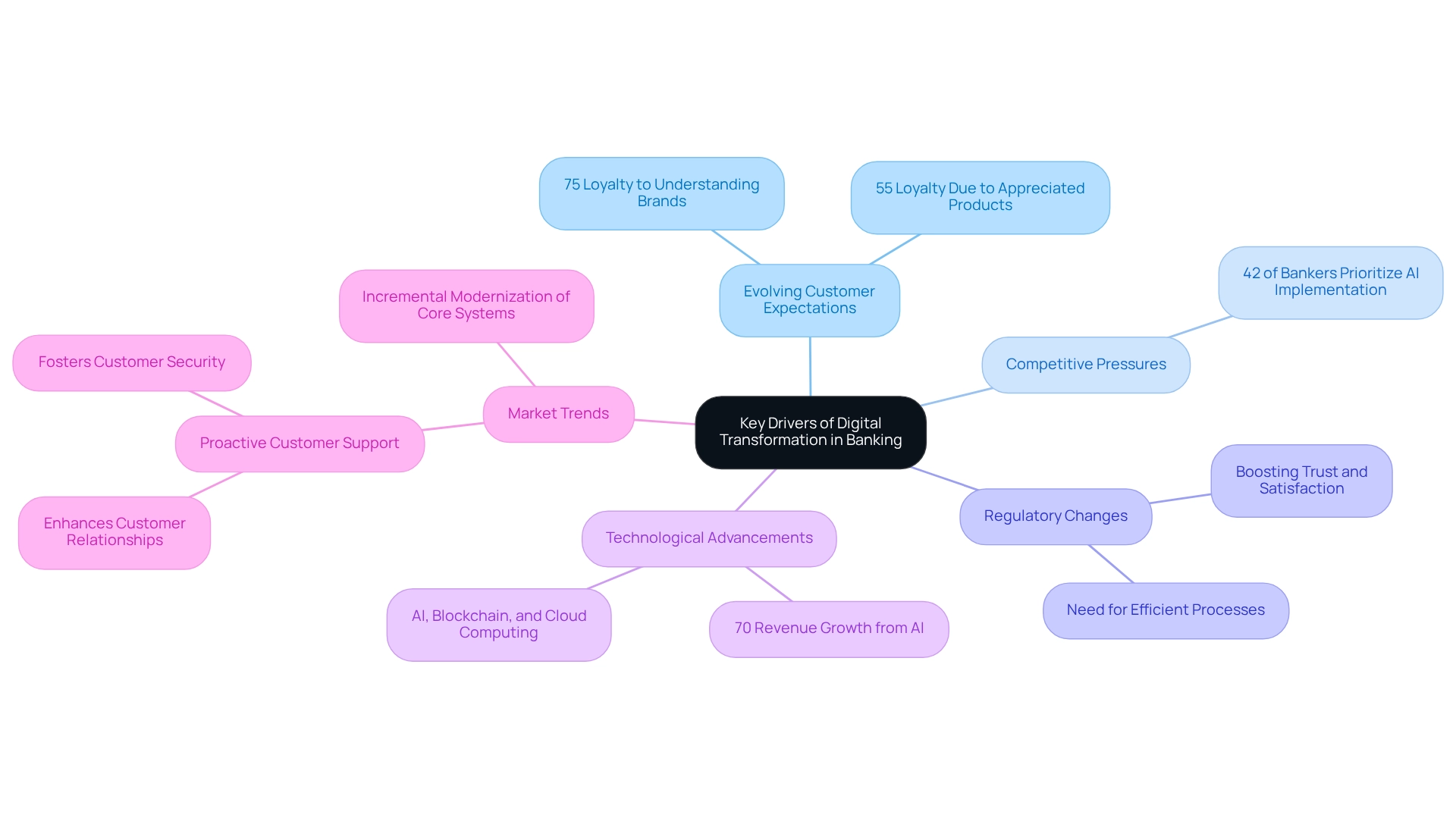
Technologies Enabling Digital Transformation in Banking
Key technologies facilitating digital transformation in banking include:
- Artificial Intelligence (AI): AI is revolutionizing customer service by deploying chatbots for instant support and offering personalized recommendations based on user behavior. Approximately 36% of financial services executives have successfully utilized AI to reduce operational costs by 10%, highlighting its efficiency. Shanker Ramamurthy, IBM Consulting’s Global Managing Director for Banking & Financial Markets, notes, “We are seeing a significant shift in how generative AI is being deployed across the banking industry as institutions shift from broad experimentation to a strategic enterprise approach that prioritizes targeted applications of this powerful technology.”
- Cloud Computing: This technology offers scalable solutions for data storage and processing, allowing financial institutions to attain flexibility and substantial cost savings. As institutions increasingly adopt cloud solutions, they can enhance their operational capabilities and respond swiftly to market changes.
- Big Data Analytics: By examining extensive amounts of data, financial institutions gain valuable insights into customer behavior, allowing them to customize services and enhance customer satisfaction. This capability is essential for staying competitive in a rapidly evolving financial landscape.
- Blockchain: Blockchain technology enhances security and transparency in transactions, significantly reducing the risk of fraud. Its decentralized nature ensures that all parties have access to the same information, fostering trust and reliability in financial operations.
- Robotic Process Automation (RPA): RPA automates repetitive tasks, leading to increased efficiency and reduced operational costs. This technology enables financial institutions to allocate resources more effectively, concentrating on strategic initiatives instead of mundane processes.
- Integration Platforms: Utilizing platforms like Avato’s Hybrid Integration Platform enables seamless connectivity between legacy systems and new technologies. This integration is vital for modernizing operations and ensuring that financial institutions can utilize their existing infrastructure while embracing innovative solutions. Avato’s platform enhances and amplifies the value of legacy systems, streamlines intricate integrations, and greatly lowers expenses, while also offering real-time monitoring and alerts on system performance, making it a crucial tool for successful technological change.
As the banking sector continues to embrace these technologies, the digital transformation banking industry showcases the integration of AI and cloud computing as a pivotal trend. Experts note a significant shift in how generative AI is being deployed, moving from broad experimentation to targeted applications that prioritize operational efficiency. A survey by Gartner in July 2024 shows varying stages of AI/ML adoption in finance, with 30% of respondents having no plans for implementation and 29% planning to implement AI/ML technologies.
With 40% of executives acknowledging the high costs associated with advanced AI technologies, the focus on strategic implementation becomes even more critical. The future of banking will undoubtedly be shaped by these advancements, making it essential for institutions to adapt and innovate. Moreover, as financial institutions prepare for open banking, utilizing integration strategies that incorporate XML technologies will be essential for guaranteeing data interoperability and sustainability in their systems.
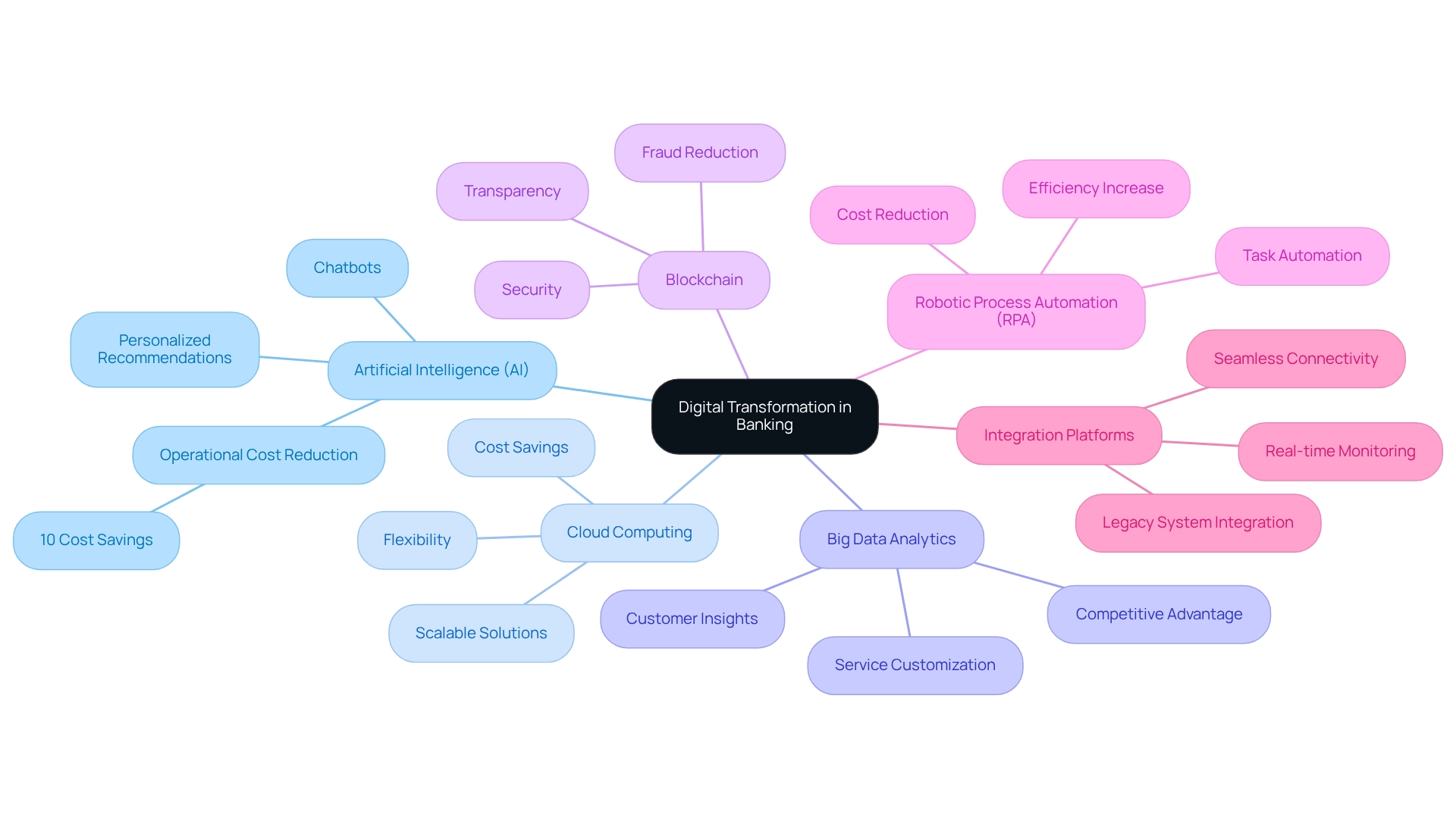
Challenges in Implementing Digital Transformation
In 2025, banks face numerous challenges as they embark on digital transformation initiatives.
-
Legacy Systems: Outdated technology poses a significant barrier, complicating the integration of new solutions. Many financial institutions struggle to modernize their infrastructure, resulting in inefficiencies and increased operational expenses. For example, European financial institutions are under heightened pressure to manage operating costs, leading many to adopt stronger cost discipline. Avato’s expert integration services, including enterprise architecture and software development, provide skilled partners who understand the complexities of legacy systems, enabling banks to overcome these hurdles effectively.
-
Regulatory Compliance: The financial sector’s stringent regulations can significantly impede change efforts. Banks must align their digital initiatives with compliance requirements, a daunting task for many. Avato’s hybrid integration platform is designed to facilitate compliance, ensuring that all integrations adhere to regulatory standards and simplifying the process for financial institutions.
-
Cultural Resistance: Resistance to changes in established processes and workflows can hinder the adoption of new technologies. This cultural inertia often obstructs the necessary transformation. To combat this, banks should cultivate a culture of innovation that encourages staff to embrace new technologies, supported by Avato’s customer-centric solutions that prioritize user engagement.
-
Data Security: With the rise of cyber threats, safeguarding customer data is more critical than ever. Banks must implement robust security measures to protect sensitive information while pursuing electronic initiatives. As Tara Porter, PhD, emphasizes, “Blockchain technology holds immense potential for secure and transparent financial transactions,” underscoring the importance of adopting advanced technologies for enhanced security. Avato’s integration solutions enable banks to leverage such technologies effectively.
-
Skill Gaps: A lack of technological skills among staff can impede the adoption of new technologies. With 70% of CEOs foreseeing skill shortages as a major challenge, organizations are increasingly investing in upskilling and automation to bridge this talent gap. The case study titled “The Growing Challenge of Skill Shortages” illustrates how organizations are addressing this issue through training and automation. Avato can assist by providing training programs and resources to enhance technology skills among employees.
-
Strategies for Overcoming Challenges: To navigate these obstacles effectively, banks should develop a comprehensive change management plan that includes:
- Investing in training programs to enhance digital skills among employees.
- Fostering a culture of innovation that encourages staff to embrace new technologies.
- Implementing agile methodologies to adapt quickly to regulatory changes and market demands.
- Collaborating with managed service providers to exchange knowledge and resources, particularly in areas like credit risk transfers and relationship management. Recent trends indicate that financial institutions are reducing surplus capital to improve financial performance while exploring collaborations to sustain customer relationships and transfer risk.
By addressing these challenges head-on, financial institutions can position themselves for effective digital transformation, ensuring competitiveness in a dynamic economic landscape. Standard Chartered’s commitment of US$1.5 billion over the next three years for its ‘Fit for Growth’ program exemplifies the financial dedication institutions are making toward achieving these change objectives. Additionally, insights from NVIDIA’s 2025 survey highlight that AI is revolutionizing trading, customer engagement, and security, emphasizing the necessity for financial institutions to incorporate advanced technologies into their strategies for enhanced operational efficiency.
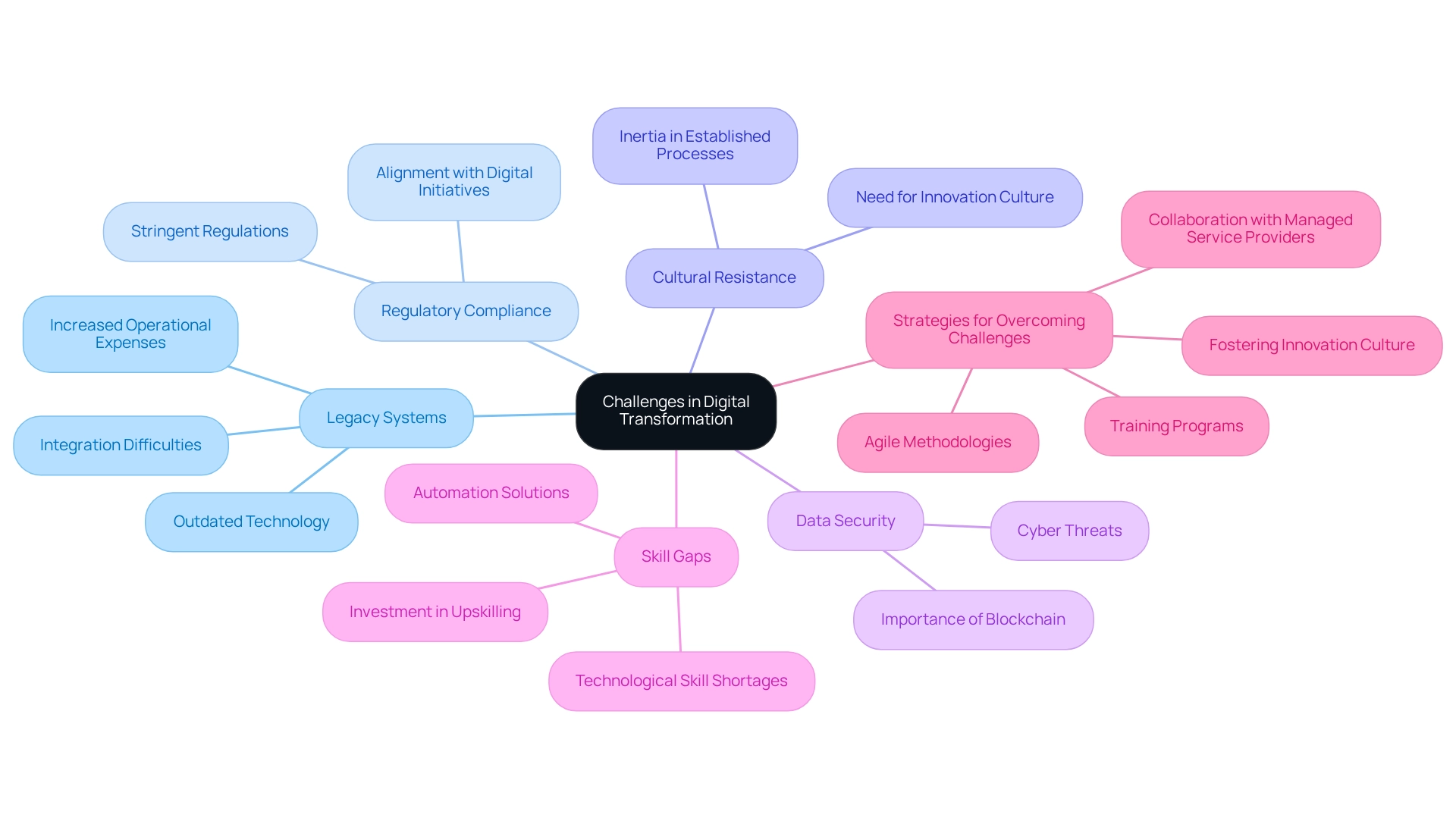
Strategic Steps for Successful Digital Transformation
To achieve successful digital transformation, banks should follow these strategic steps:
-
Define Clear Objectives: Establish specific goals for what the change should achieve. This clarity is essential, as it guides the entire process and aligns efforts across the organization.
-
Assess Current Capabilities: Evaluate existing systems and processes to identify gaps. Understanding the current state is crucial for determining the necessary changes and investments. Leveraging Avato’s hybrid integration platform can facilitate this assessment by enabling banks to build on their existing legacy systems rather than discarding them.
-
Develop a Roadmap: Create a detailed plan outlining the steps needed to reach the objectives. A well-structured roadmap not only provides direction but also helps in managing expectations and resources effectively. This roadmap should incorporate strategies for integrating open banking solutions, which are essential for the digital transformation banking industry, ensuring secure and reliable connections between applications and compliance with stringent security protocols.
-
Engage Stakeholders: Involve key stakeholders throughout the process to ensure buy-in and support. Engaging stakeholders is vital, as their insights can shape the transformation strategy and foster a sense of ownership. As Marcus Schwarz noted, “The impact of digital banking on stakeholders is profound, influencing various aspects of the financial ecosystem.”
-
Invest in Technology: Allocate resources to acquire the necessary technologies and tools. With deposit costs projected to rise to 2.03% in 2025, the digital transformation in the banking industry becomes even more critical for maintaining competitive advantage through the right technology. Integrating biometric authentication techniques is one instance of how financial institutions are updating their security protocols, shifting from conventional passwords to improve user experiences. Additionally, harnessing generative AI can streamline operations and improve customer interactions within the digital transformation banking industry, as evidenced by its growing use in developing sophisticated chatbots and virtual assistants.
-
Monitor Progress: Regularly review progress against the roadmap and adjust as needed. Continuous monitoring enables financial institutions to remain adaptable and reactive to any challenges that emerge.
- Continuous Improvement: Foster a culture of innovation and adaptability to respond to changing market conditions. This mindset is essential for navigating the complexities of the online banking environment, especially considering the regulatory challenges and cybersecurity threats that the sector encounters.
Case studies show that numerous financial institutions struggle with outdated technology that hinders growth and modernization efforts. The case study titled “Core Banking Modernization Challenges” illustrates this struggle, showing that incremental modernization strategies, such as wrapping legacy systems with innovative layers and utilizing generative AI for code rewriting, are being explored to upgrade core banking systems effectively. By establishing clear goals and involving stakeholders, financial institutions can develop an effective plan for technological advancement that not only addresses present needs but also prepares them for future achievement.
Call to Action: To discover more about how Avato can support your technological change journey, explore our resources or reach out to us for a consultation.
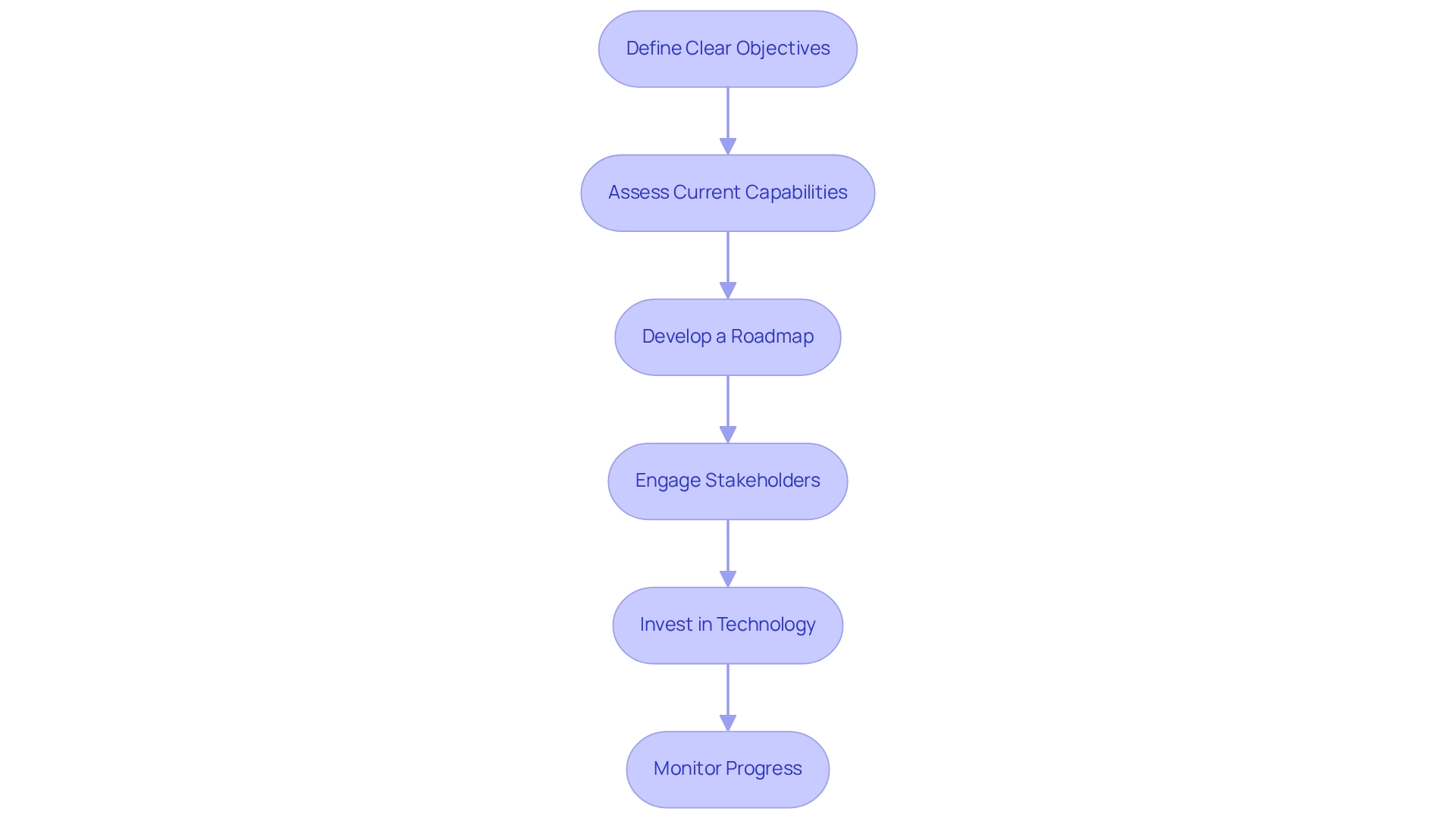
Benefits of Embracing Digital Transformation
Embracing digital transformation presents a wealth of advantages for banks, particularly as the financial landscape evolves in 2025:
- Improved Customer Engagement: Enhanced digital experiences significantly boost customer satisfaction and loyalty. Banks utilizing generative AI tools can create personalized interactions, leading to deeper client relationships and increased retention rates. The NVIDIA 2025 survey highlights that 21% of profitable generative AI applications focus on customer experience, showcasing the potential for AI-powered chatbots and virtual assistants to transform customer interactions.
- Operational Efficiency: Streamlined processes not only reduce operational costs but also enhance service delivery. For instance, DBS Bank achieved a remarkable 26% reduction in compliance costs through automated regulatory reporting, showcasing how technology can drive efficiency. The survey indicates that nearly 70% of firms reported at least a 5% revenue increase attributable to AI implementations, underscoring AI’s role in enhancing operational efficiency. As Vikram, Vice Chair and US Financial Services Industry Leader at Deloitte, observes, “The ability to adapt and innovate is crucial for financial institutions to thrive in today’s competitive environment.”
- Data-Driven Decision Making: Access to real-time information empowers financial institutions to make informed strategic decisions. This capability is essential in a swiftly evolving market, enabling institutions to adjust their strategies according to current trends and client behaviors. The survey reveals that over half of financial professionals now use generative AI for document processing and report generation, streamlining operations and enhancing productivity across various departments. Enhanced agility in the digital transformation banking industry allows financial institutions to react quickly to market shifts and changing client demands. This agility is essential for maintaining competitiveness in an industry where customer expectations are continuously rising. The survey suggests that successful institutions are embedding AI into their strategic plans, aiming for enterprise-wide adoption, which is vital for agility.
- Competitive Advantage: By positioning themselves as leaders in innovation, financial institutions can differentiate themselves in the crowded financial sector. Incremental modernization of core systems is a recommended strategy for shedding technical debt and fully leveraging AI capabilities, further enhancing their competitive stance. The survey indicates that 25% of firms plan to explore new business opportunities through AI, highlighting the competitive imperative.
Case Studies: An examination of successful banking digital changes reveals significant benefits. For instance, financial institutions that have adopted data collaboration are redefining their roles within the financial ecosystem, transitioning from independent entities to essential components of a collaborative network. This shift not only enhances operational efficiency but also fosters innovation.
As European financial institutions encounter pressures to handle operating expenses, many anticipate that cost increases will exceed revenue growth in 2024, rendering these changes even more essential. Notably, Avato has enabled institutions like the BC Provincial Health Services Authority to align their outcomes effectively, demonstrating the tangible benefits of its hybrid integration platform.
In summary, the advantages of digital transformation in the banking industry for financial institutions in 2025 are clear: enhanced customer engagement, operational efficiency, data-driven decision-making, increased agility, and a competitive edge. Avato’s dedicated hybrid integration platform plays a crucial role in simplifying complex integrations and enhancing business value, enabling financial institutions to thrive in this evolving landscape. With features such as real-time monitoring, alerts on system performance, and cost reduction capabilities, Avato is positioned to assist banks in navigating these changes.
As the financial services sector continues to advance, those who excel in these changes will prosper.
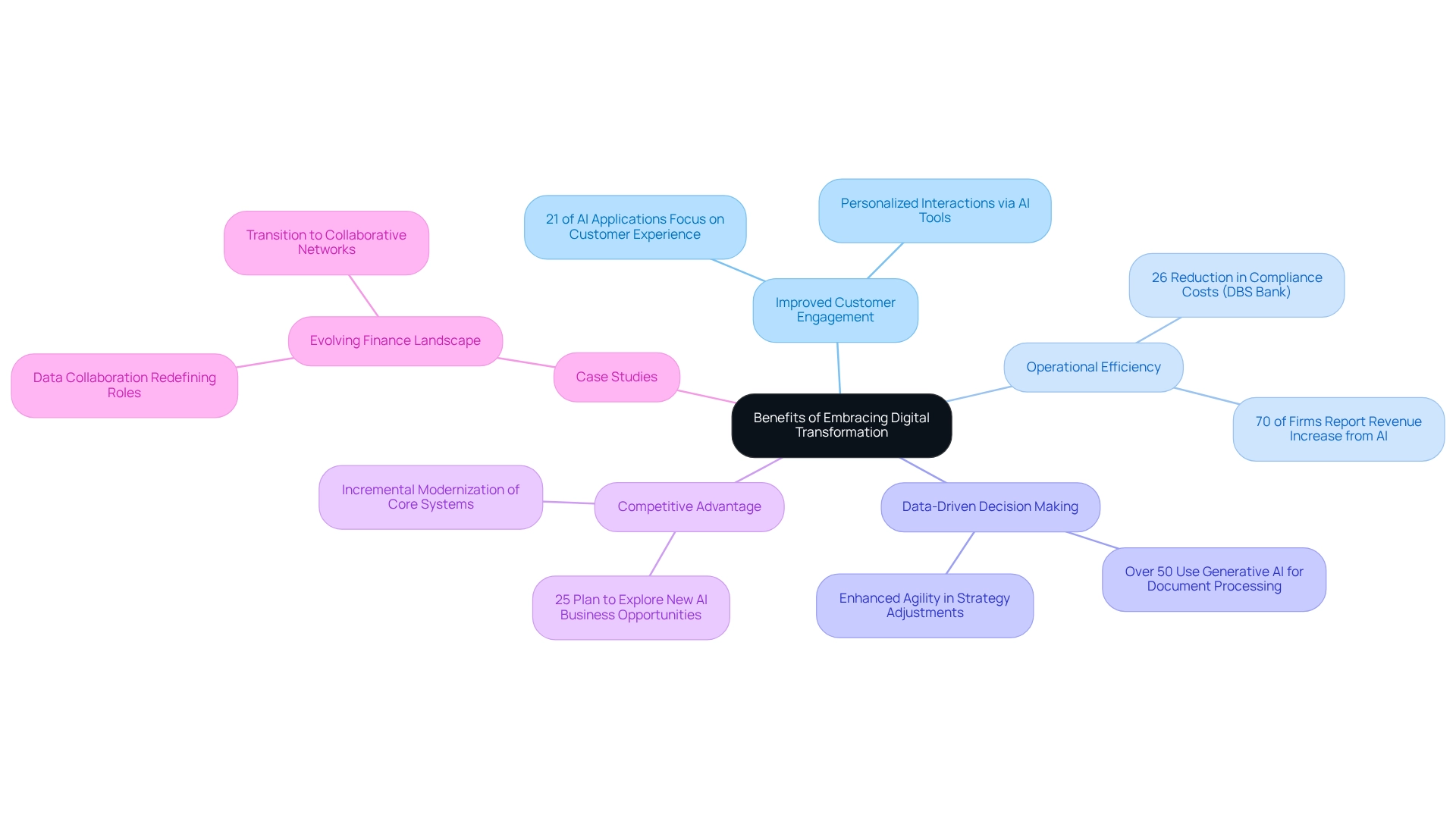
The Role of Leadership in Digital Transformation
Effective leadership is crucial for driving successful change in the digital transformation banking industry. Leaders must focus on several key components:
-
Vision and Strategy: Articulating a clear and compelling vision for transformation that aligns with overarching business objectives is essential. This vision acts as a roadmap, guiding the organization through the complexities of the digital transformation banking industry, particularly as AI becomes integral to financial services.
-
Cultural Change: Cultivating a culture that embraces innovation and adaptability is imperative. Encouraging employees to engage with new technologies, such as generative AI tools, fosters an environment where change is not only accepted but actively pursued. The recent NVIDIA survey highlights that 52% of financial services professionals are now using generative AI, indicating a shift towards practical applications that enhance customer engagement and operational efficiency.
-
Resource Allocation: Assigning sufficient resources—both financial and human—to support change initiatives ensures that projects are adequately funded and staffed, which is essential for their success. The survey indicates that nearly 70% of firms have seen revenue increases due to AI implementations, underscoring the need for strategic investment in AI capabilities.
-
Stakeholder Engagement: Involving stakeholders at all levels of the organization is crucial for fostering support and dedication to change initiatives. This inclusive approach helps mitigate resistance and fosters a sense of ownership among employees. As organizations in the digital transformation banking industry integrate AI into their strategic plans, engaging stakeholders becomes even more critical to ensure alignment and support.
-
Performance Metrics: Establishing clear metrics to assess the success of change initiatives is essential. These metrics allow leaders to evaluate progress, make informed adjustments to strategies, and ensure that the transformation aligns with business goals. The NVIDIA survey suggests that firms focusing on AI applications with proven ROI, such as trading and portfolio optimization, are more likely to achieve significant operational improvements.
-
Leadership Development: Investing in training programs to enhance technological leadership skills within the organization is critical. As the landscape of the digital transformation banking industry evolves, leaders must be equipped with the knowledge and skills necessary to navigate technological challenges effectively. The talent gap in AI specialists, as highlighted in the survey, emphasizes the need for comprehensive talent strategies that include recruitment and upskilling.
By 2025, the significance of these elements will be underscored by ongoing economic uncertainties, with 22% of organizations recognizing this as a major challenge to their technological advancement efforts. Successful instances of vision and strategy in the digital transformation banking industry highlight the necessity for strong leadership to steer organizations through these adjustments. For instance, Gustavo Estrada from BC Provincial Health Services Authority noted, “Avato has the ability to simplify complex projects and deliver results within desired time frames and budget constraints,” illustrating effective leadership in project management.
Case studies, such as the ‘Implementation of New Technologies,’ demonstrate that effective leadership enhances operational capabilities and positions organizations for success in the digital transformation banking industry, ultimately leading to improved performance and a competitive edge in the financial services sector. Furthermore, ensuring a consistent user experience across various enterprise web applications in banking is a critical operational benefit that strong leadership can provide. Additionally, the implementation of open banking regulations, including the EU’s revised Payment Services Directive (PSD2), presents ongoing changes in the banking sector that leaders must navigate.
To assist organizations in their technological evolution journey, Avato provides customized AI evaluations aimed at helping leaders engage stakeholders, distribute resources efficiently, and safeguard their systems for the future. By utilizing insights from the NVIDIA survey and Avato’s expertise, banking leaders can navigate the complexities of technological change with confidence.
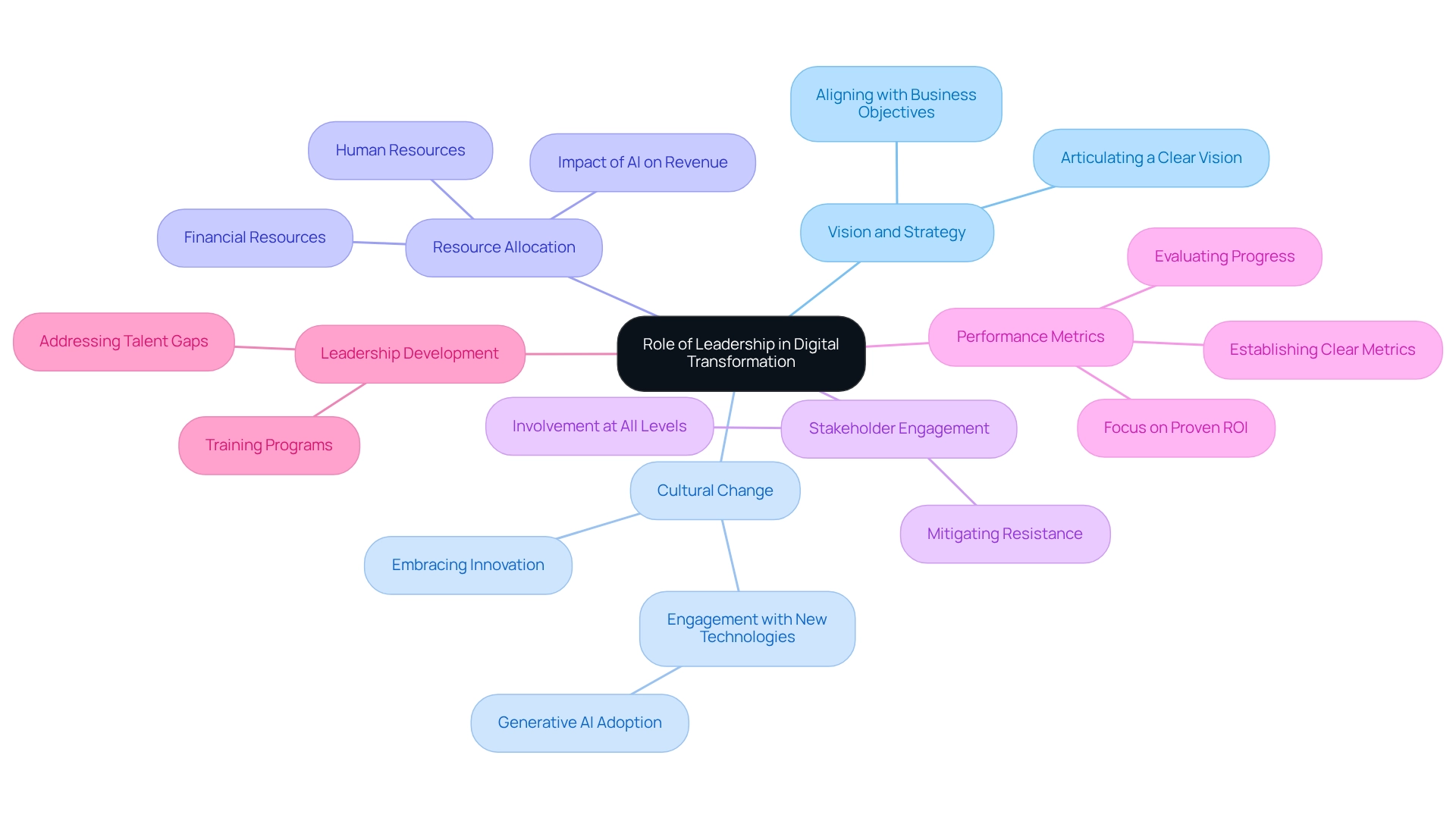
Your Essential Checklist for Digital Transformation Success
-
Define Objectives: Clearly outline your goals for digital change, ensuring they align with the broader strategic vision of the bank. This clarity is crucial, as 22% of executives mention economic uncertainty as a significant challenge to executing these changes, emphasizing the need for well-defined objectives. How can open banking enhance your objectives by streamlining product delivery and improving customer experiences?
-
Assess Current State: Conduct a thorough evaluation of existing systems, processes, and capabilities. Understanding your current landscape is crucial for identifying gaps and opportunities for improvement. As highlighted by industry specialists, evaluating the current condition is a fundamental step in any successful change initiative. IT decision-makers have recognized cyber threats, ESG objectives, and skills shortages as primary challenges obstructing progress in digital advancement initiatives, underscoring the complexities involved. Leverage Avato’s hybrid integration platform to build on existing legacy systems rather than discarding them, ensuring a smoother transition to open banking.
-
Engage Leadership: Secure strong support from leadership to drive the change process. Effective leadership is vital for fostering a culture that embraces innovation and change, necessary for overcoming resistance and ensuring buy-in across the organization. As Gustavo Estrada states, “Avato has the ability to simplify complex projects and deliver results within desired time frames and budget constraints,” emphasizing the role of leadership in leveraging technology for successful outcomes.
-
Invest in Technology: Identify and invest in the technologies that will support your change objectives. This includes not only modernizing legacy systems but also adopting new solutions that enhance operational efficiency and customer experience. Notably, 87% of consumers prioritize convenience over security in financial services. How can you ensure that your technology investments align with consumer expectations? Ensure that your integration solutions are compliant with stringent security protocols to mitigate risks associated with open banking.
-
Develop a Change Management Plan: Create a comprehensive strategy for managing the transition. This plan should address potential resistance and outline how to communicate changes effectively to all stakeholders, ensuring a smoother transition. Engaging stakeholders early in the process can help in gathering structured requirements and aligning expectations.
-
Monitor and Measure Progress: Establish key performance indicators (KPIs) to track the success of your initiatives. Regular monitoring enables prompt modifications and guarantees that the change stays in line with your goals. The obstacles recognized in the case analysis on electronic advancement can act as a reference for tracking difficulties and modifying approaches accordingly. Continuous monitoring and analytics will play a crucial role in maximizing integration performance.
-
Foster a Culture of Innovation: Encourage continuous improvement and adaptability within the organization. A culture that emphasizes innovation will enable employees to share ideas and solutions, propelling the change ahead. Addressing the challenges highlighted in the case study can help organizations cultivate this culture effectively, particularly in the context of integrating new tools with existing assets.
-
Review and Revise: Regularly revisit your checklist to ensure it remains aligned with evolving goals and market conditions. This iterative approach is essential for maintaining relevance in a rapidly changing financial landscape. By integrating structured requirements management into your review process, you can ensure that your systems are future-proofed and ready for ongoing integration challenges.
By following this essential checklist, banks can navigate the complexities of digital transformation effectively, ensuring they remain competitive and responsive to customer needs in 2025 and beyond.

Conclusion
Embracing digital transformation is not just an option but an imperative for banks aiming to thrive in the rapidly evolving financial landscape of 2025. The integration of advanced technologies—such as artificial intelligence, cloud computing, and big data analytics—offers significant benefits, including improved customer engagement, enhanced operational efficiency, and data-driven decision-making. As the banking sector encounters increasing competitive pressures and evolving customer expectations, leveraging these technologies becomes essential for maintaining a competitive edge.
However, the journey toward digital transformation presents formidable challenges. Legacy systems, regulatory compliance, cultural resistance, and skill gaps are significant hurdles that banks must navigate effectively. By adopting strategic steps—such as:
- Defining clear objectives
- Assessing current capabilities
- Engaging stakeholders
- Investing in technology
banks can overcome these obstacles and position themselves for success. Leadership plays a crucial role in this transformation, providing the vision and resources necessary to cultivate a culture of innovation and adaptability.
Ultimately, the successful execution of digital transformation initiatives will not only enhance customer experiences but also drive long-term growth and sustainability for financial institutions. As the landscape continues to evolve, those banks that prioritize digital transformation will be better equipped to meet the demands of a tech-savvy customer base and thrive in an increasingly competitive market.

